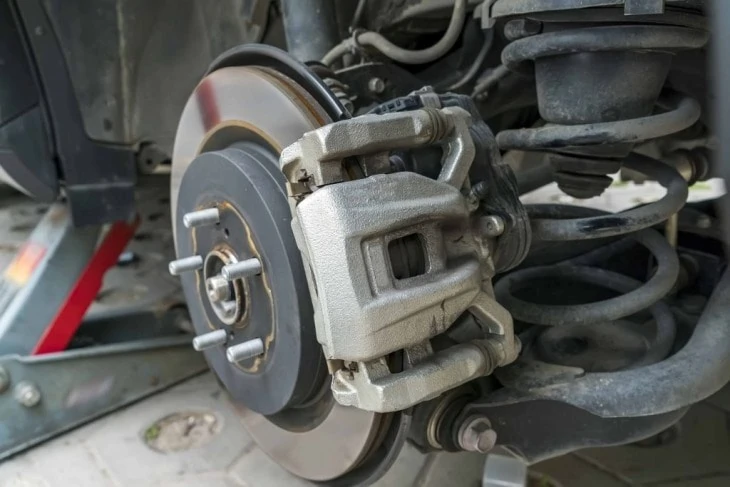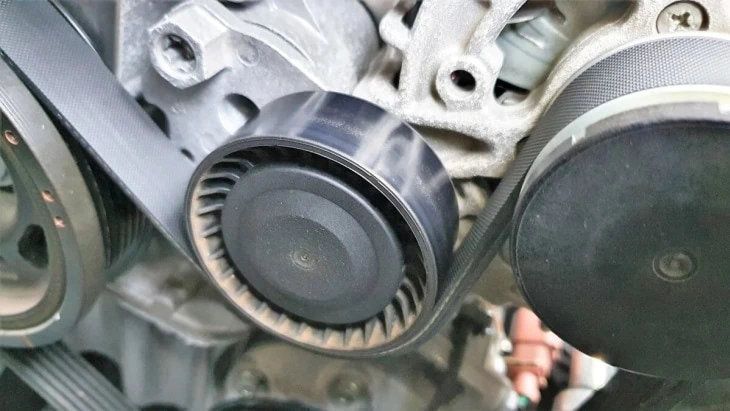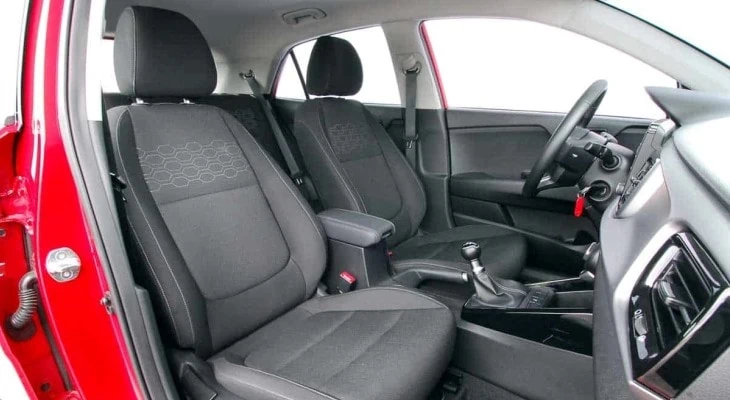Rattling noises from your car are annoying, obnoxious, and potentially embarrassing. If you want to find the source and stop it, it helps to know what to look for. Different parts of the car have different components that can cause a rattle noise.
A rattle from the passenger front while driving may point to a brake, axle/suspension problem, or in some cases an issue with your engine. Any loose parts, including interior panels, windows, and even mirrors can also cause your noise. Furthermore, rusted or loose heat shields and brake backing plates can cause troublesome noises.
Table of Contents
Check the Passenger Front Suspension

If your noise seems to be coming from the wheel area, the suspension is where you should start. Old or worn components can cause a rattle noise. Inspecting for loose nuts and bolts is also a good idea, even just as general maintenance.
Sway Bar End Links
End links are a very common cause for rattles. When they go bad, the ball joints that connect the bar to the frame or body develop excessive play or looseness. This can cause a rattle any time the suspension shifts, such as when you hit a bump.
When end links fail, the noise they make is AWFUL. It’s a loud, metallic rattling noise any time they move. It can be extremely annoying and will turn into a safety issue if left unchecked for too long.
Grab the end link in question and shake it firmly in all directions, and do the same with the sway bar itself near the end link. Most of the time if they’re bad enough to make noise, they will make it even when moved by hand. Replace the link if necessary, and use new mounting nuts as well.
Springs and Shocks
Check that you don’t have a broken spring or strut/shock. Usually, it will be pretty clear if the spring is broken, but the shocks can be trickier depending on your car.
Similar to the end links, grab the shock and give it a shake. You may have to use a pry bar to see if you can move it enough to make it shift or clunk. It’s possible a mounting point has rusted and broken, or you could have a loose mounting nut or bolt.
You should also take a look at the tops, especially on struts. Loose mounting nuts on the top could also cause a rattle, as can the top itself if broken or damaged. Make sure everything is tight and replace anything that’s damaged.
Other Suspension and Steering Items

It’s less common to get a rattle from these parts, but it’s not impossible. Tie rod ends and control arm ball joints can develop play just like your end links. Check them by jacking the car up and shaking the wheel gently from side to side and top to bottom.
For safety, always use a jack stand to support your car while working on it. Never get under a car that is only supported by a jack.
If you can feel looseness in the wheel when rocking it, take a look at the tie rod ends and control the arm ball joint while doing so. If you see movement there, it’s time for a replacement.
The steering rack itself may also be the cause of your rattle. If it has enough play to make noise, usually you can shake the inner tie rod end by hand to hear it. If this is the case it may be best to have a professional take a look.
Inspect the Passenger Front Brake, Wheel Bearing and CV Axle
The suspension isn’t the only thing in the wheel area that can cause a rattle noise. Any of the components in this section of the car are potential culprits, so it’s a good idea to make sure everything looks good.
Inspect Your Brakes
Brakes can cause all sorts of different noises, even when not being used. Here are common issues to look for:
- Rusted or damaged backing plate
- Rusted or damaged rotor
- Brake pads rocking/loose in bracket or not properly lubricated
- Pads worn and grinding into the rotor
- Loose caliper bolts or pins
See If Your Wheel Bearing Has Play

Rock the tire back and forth gently, just like before. If you feel play but don’t see any in the tie rod or ball joint, you may have a very worn wheel bearing. This can definitely cause a rattle and other noises.
These can sometimes be difficult to accurately diagnose, but if it’s very worn it will be easy to tell. You’ll have to remove all the brake components from the right front (and the CV axle if front-wheel drive). Once you’ve done this, spin the hub and see how it feels.
If it’s very worn you may be able to rock it back and forth by hand as well. The hub should spin smoothly, without any noise or feeling notchy. If it doesn’t spin smoothly or has play, get it replaced as soon as you can.
CV Axle Failure
Another very common cause of rattles, the CV joints in your axles can make an awful noise when they fail. This is especially true when making a turn.
Take a look at the boots to see if they’re torn and slinging grease. If so, the axle is likely making your rattle noise. You may be able to shake it here as well to check for looseness.
Sometimes axles can fail without any obvious visual signs. If you’re unsure, have a good shop inspect them.
Other Exterior Rattles
Here is a short list of other common rattle sources that are easy to check:
- Loose or damaged fender liner, splash shield or object rattling on top of splash shield
- Loose exhaust heat shield
- Loose body panels
- Loose passenger side mirror
- Looseness in roof rack or other accessories (such as a brush guard)
With any of these, you can usually shake, tap on or otherwise manipulate the part to see if you can duplicate the noise. Don’t forget to check all your bolts for tightness as well.
Interior Rattles
If the noise seems to be inside the car there is a lot you can check. First, make sure any objects are removed from the car and glovebox. Sometimes the simplest thing can be the answer, and you could save a lot of time by eliminating a loose item in your car.
Interior Panels

This is relatively simple but it can be time-consuming. Have a friend drive you while you’re in the passenger seat. Listen for your rattle and start putting pressure on panels in the area the noise seems to be coming from.
Check parts of the dash, the mirror, door panel, sun visors, and everything else you can reach. If you start to FEEL the noise you know you’re close.
If the noise stops, you found the source. You can use some felt tape (like this) underneath where it’s rattling to quiet it down.
Inside the Door
If the noise seems to be coming from inside the door, you can remove the panel and see what’s going on. There may be an object stuck inside rattling around.
Even if there’s not something stuck in there, you can still check the window and regulator to make sure they’re tightened properly. There should be one or two bolts holding the window to the regulator.
Sometimes to get to the bolts you’ll need to raise or lower the window till the bolts line up with access holes in the door frame. Make sure the bolts are nice and snug but don’t tighten them too much or you could break the window!
Under Hood Rattles
It’s usually easy to tell if your rattle is coming from under the hood since most of the time the noise will change with engine speed. Even if it doesn’t, you can check a few things for the possibility of a noise.
Engine Pulleys

The idler pulleys and tensioner pulley have bearings in them to minimize friction, just like your wheel hub. Also just like your wheel hub, they can fail and potentially cause a rattle.
Checking them is similar as well. Turn the engine off and remove the belts. Spin your pulleys and rock them side to side to check for looseness, play, or roughness.
The alternator, power steering pump, and AC compressor can also be checked, but often won’t show symptoms as easily. Any of the pulleys that feel rough or loose should be tightened to see if the looseness goes away. If not, it’s time for a new one.
Rattling from the Engine Itself
If the rattle seems to come from the engine itself, check your oil. If it’s not full, top it off and see if the problem is still there.
If the noise persists, you should have it checked by a pro. It could be a timing chain or cam sprocket issue. In the worst-case scenario, you could be looking at a rod-bearing failure.
Wrapping Up
Remember, general rules of thumb for a rattle noise point to something being loose. This could be a bolt, a joint, or a damaged component. Follow your ears and eyes and you’ll be headed in the right direction.
Be careful around all moving parts and while working under the car. If you feel your noise is a safety concern and are unsure, have a well-known shop take a look at it.

